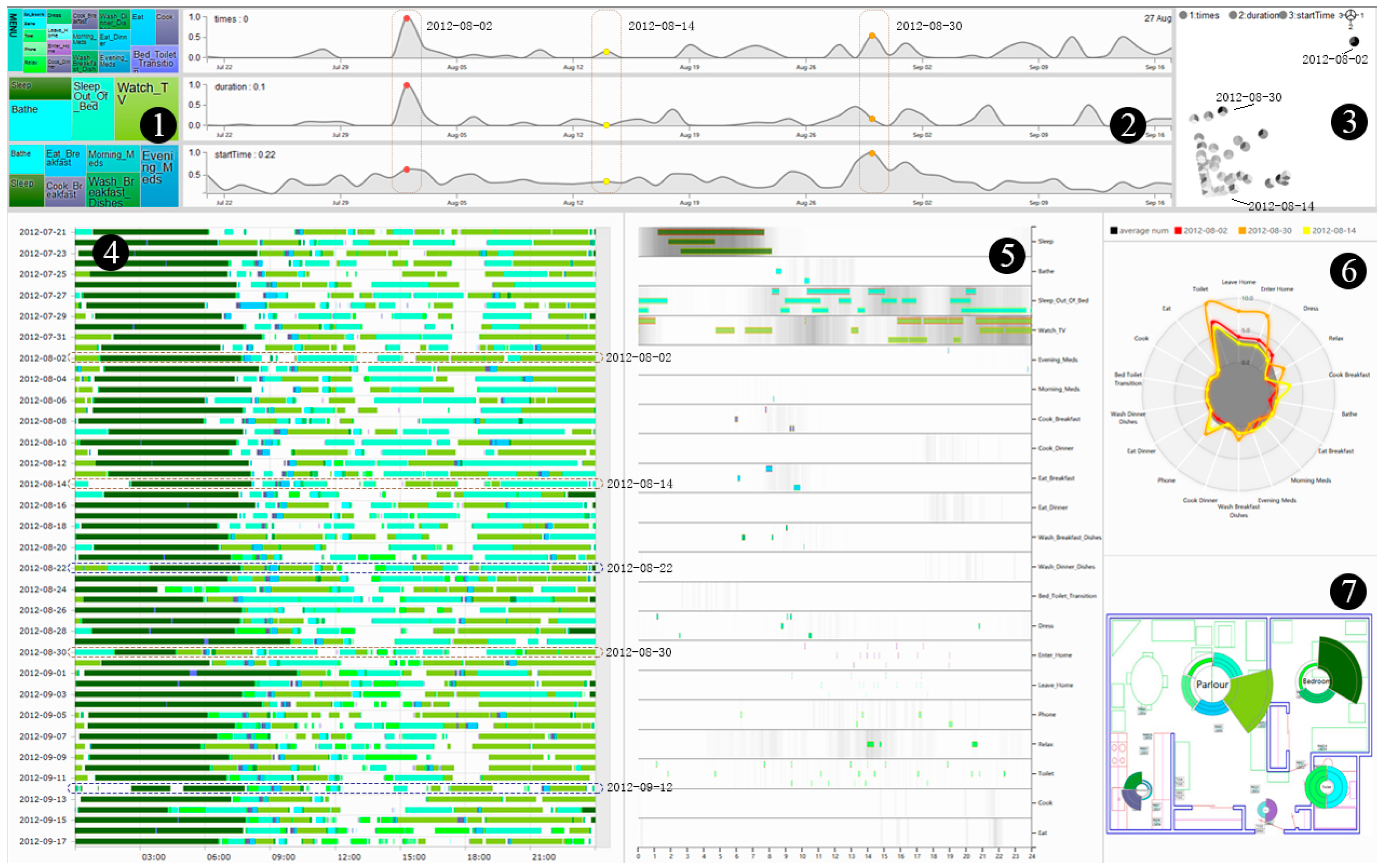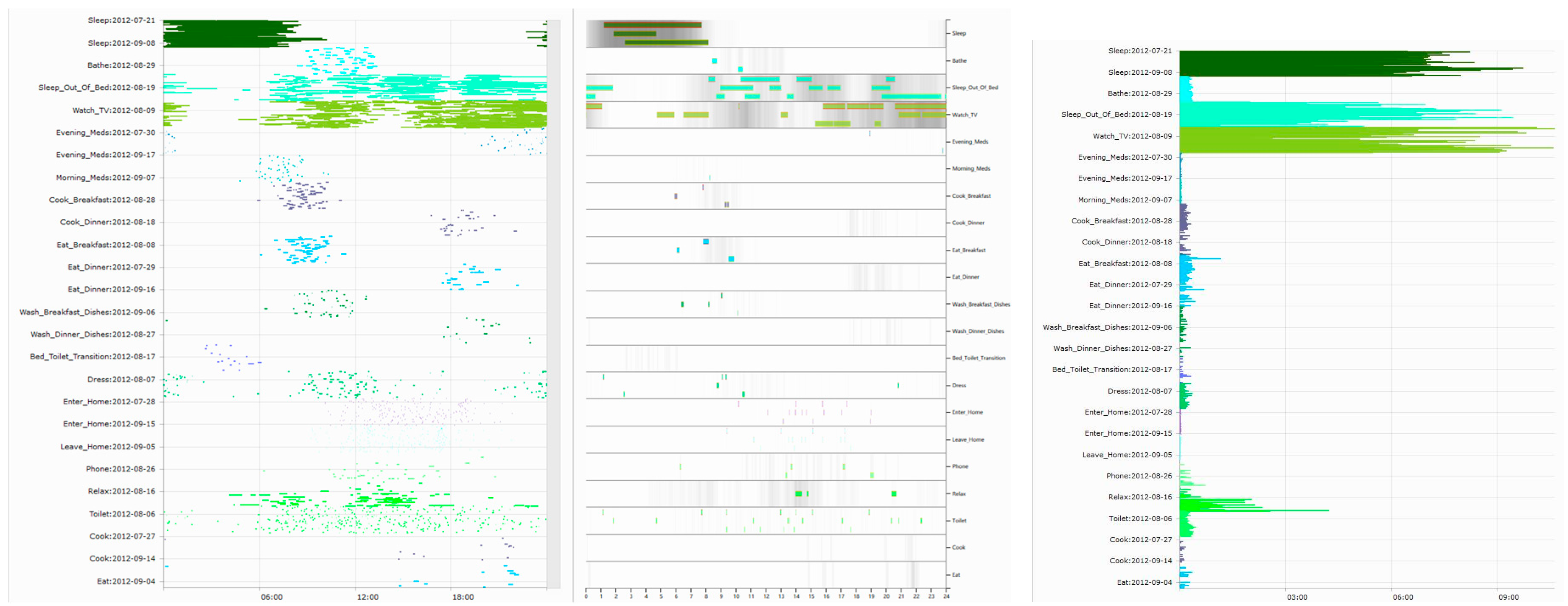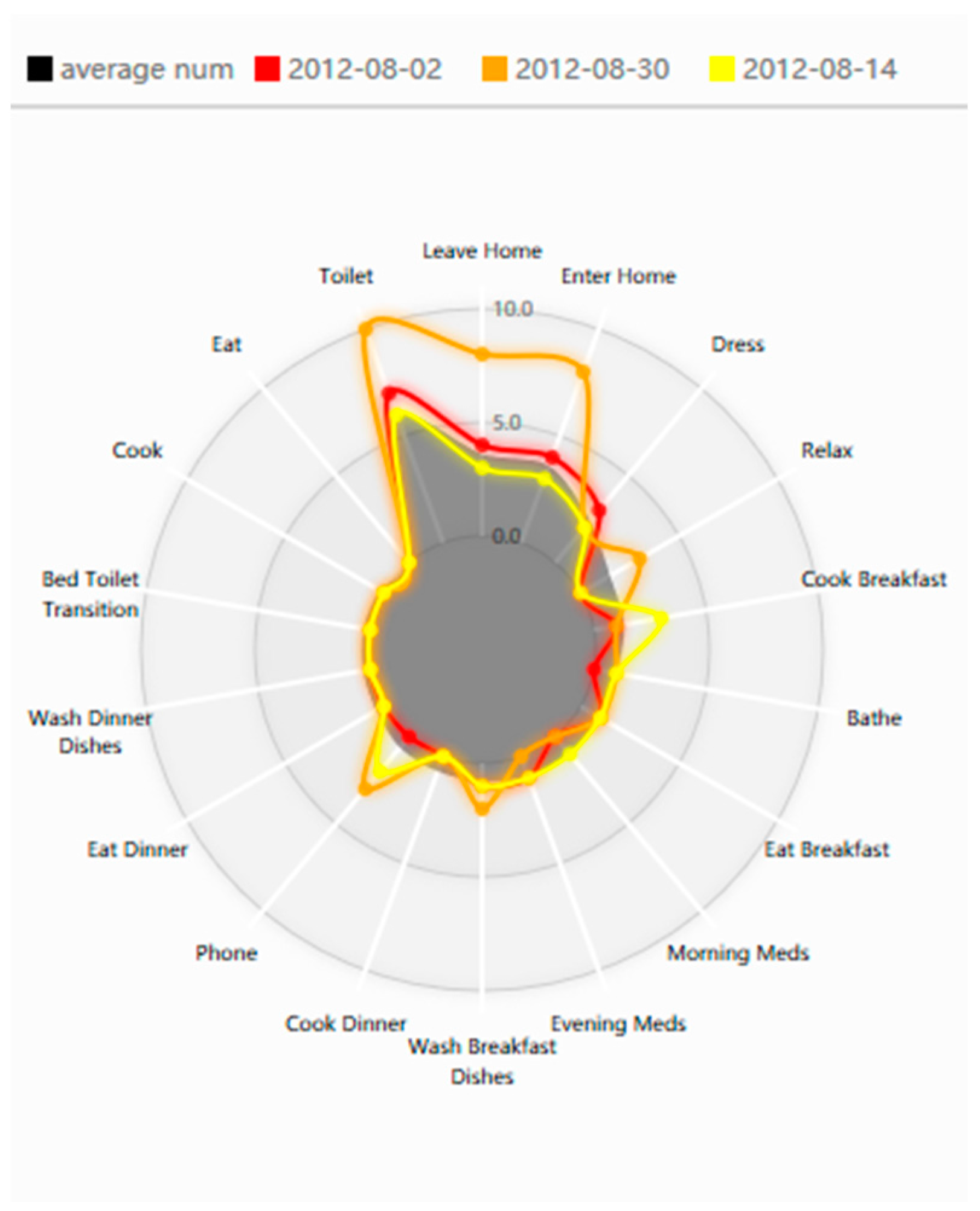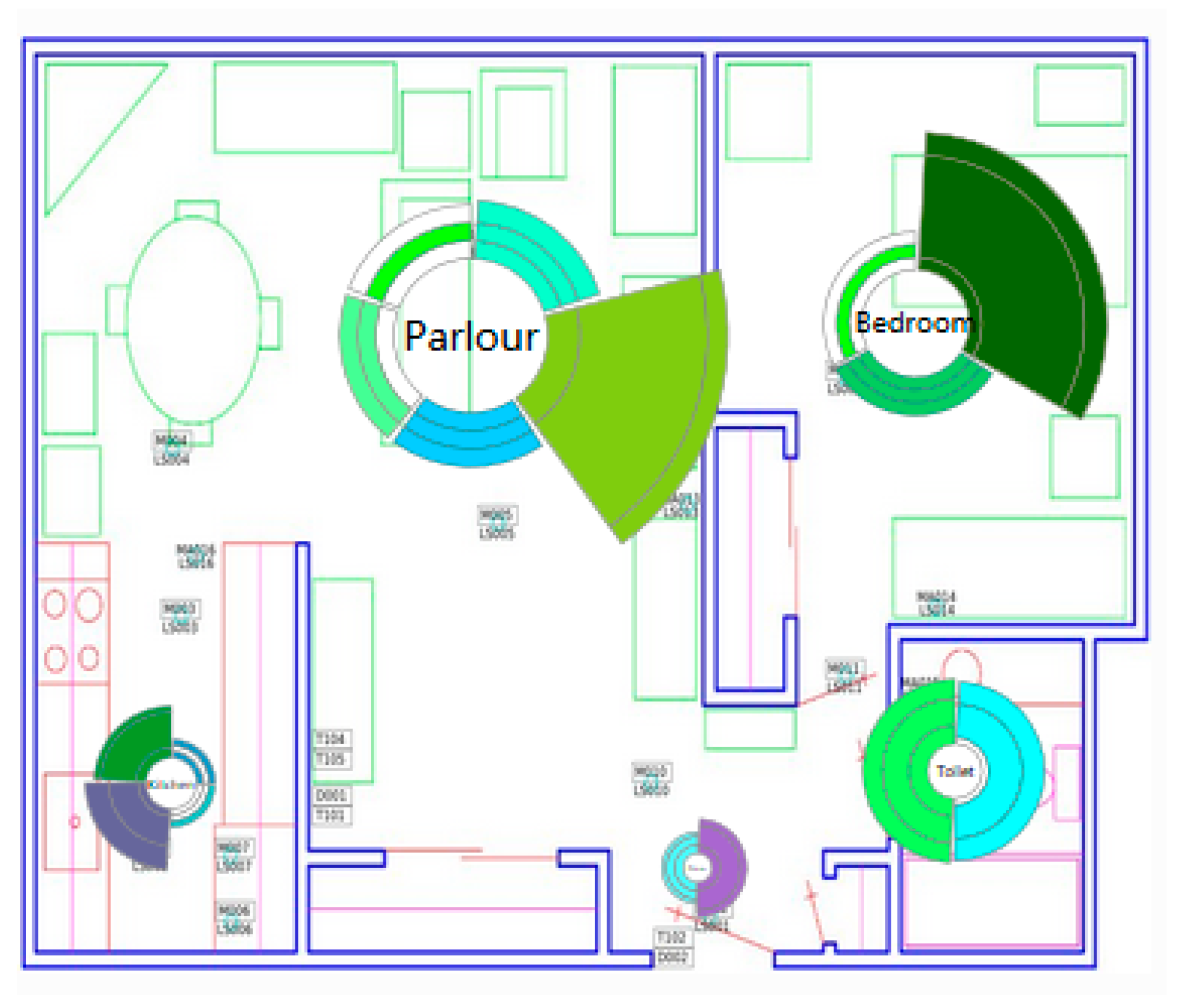A Visual Analytics Approach for Detecting and Understanding Anomalous Resident Behaviors in Smart Healthcare
Abstract
:1. Introduction
- (1)
- Employing LOF algorithm to anomaly detection of residents’ daily activities, which can detect anomalous activities rapidly and effectively.
- (2)
- Designing a series of visual views to analyze, compare and interpret users’ various daily activities, which will help researchers locate anomalous events of residents’ life rapidly, compare users’ behaviors of different dates, and observe detailed information of anomalous events.
2. Related Work
3. Data Description and Task Profile
3.1. Data Description
3.2. Task Profile
3.2.1. Interactive Activity Classification and Summary
3.2.2. Combined Anomaly Detection and Summary of Results
3.2.3. Exploration of Residents’ Anomalous Behaviors and Their Spatial and Temporal Distribution
3.2.4. Rapid Anomaly Comparison
4. Anomaly Detection
4.1. Characteristics Categories
- Duration: A healthy resident’s activity often follows a certain rule, meaning that its value of duration fluctuates around a fixed value. According to the activity’s duration, we can calculate anomaly value of residents’ activities in each date with LOF algorithm.
- Times: Similar to Duration, occurrence times of a resident’s activity maintain around a fixed value. According to the occurrence times of an activity, we can also calculate anomaly value with LOF algorithm.
- Start time: Similar to Duration and Times, we can calculate anomaly value of residents’ activities in each date with LOF algorithm with the help of standard deviation.
4.2. Characteristics Extraction
- Duration: When using Duration to calculate, activities of long duration have greater influence on the calculation of anomaly degree, while activities of short duration such as “leave home” and “toilet” have few effects on such calculation, which could almost be neglected. Hence, activities of long duration should be chosen when calculating anomaly degree in this category.
- Times: Activities with short duration are not suitable for calculation of Duration anomaly degree, but they are fit for calculation of Times anomaly degree. For instance, how often a resident goes to bathroom exerts a great influence on reflecting anomaly degree of his behavior on that day, whereas how long a resident takes in toilet totally in a day is insignificant in calculation. Therefore, activities of short duration should be chosen when calculating anomaly degree in the category of Times. In addition, the activity with relatively stable frequency is more valuable when calculating anomaly degree of Times, meaning that it should be given priority in selection.
- Start time: Start time of some activities can also be regarded as the evidence to judge if anomalous events occurred. For instance, duration of “sleep” may be around a certain number of hours, if they go to bed too early or too late it means they behaved unusually on that day.
4.3. Local Outlier Factor
5. Analysis Interface and Visualization
5.1. Activity Tree Map View
5.2. Anomaly Grading View
5.3. Date Map View
5.4. Gantt Chart View
5.5. Heat Gantt Chart View
5.6. Radar Map View
5.7. Space Radar Map View
6. Case Study
7. Conclusions
Acknowledgments
Author Contributions
Conflicts of Interest
References
- Acampora, G.; Cook, D.J.; Rashidi, P.; Athanasios, V.V. A Survey on Ambient Intelligence in Healthcare. Proc. IEEE Inst. Electr. Electron. Eng. 2013, 101, 2470–2494. [Google Scholar] [CrossRef] [PubMed]
- Luo, X.; Zhang, D.; Yang, L.T.; Liu, J.; Chang, X.; Ning, H. A Kernel Machine-based Secure Data Sensing and Fusion Scheme in Wireless Sensor Networks for the Cyber-physical Systems. Future Gen. Comput. Syst. 2016, 61, 85–96. [Google Scholar] [CrossRef]
- Dawadi, P.N.; Cook, D.J.; Schmitter-Edgecombe, M. Automated Cognitive Health Assessment Using Smart Home Monitoring of Complex Tasks. IEEE Trans. Syst. Man Cybern. Syst. 2013, 43, 1302–1313. [Google Scholar] [CrossRef] [PubMed]
- Rashidi, P.; Cook, D.J. COM: A Method for Mining and Monitoring Human Activity Patterns in Home-based Health Monitoring Systems. ACM Trans. Intell. Syst. Technol. 2013, 4, 64. [Google Scholar] [CrossRef]
- Dawadi, P.N.; Cook, D.J.; Schmitter-Edgecombe, M. Automated Cognitive Health Assessment from Smart Home-Based Behavior Data. IEEE J Biomed. Health Inform. 2015, 20, 1188–1194. Available online: http://ieeexplore.ieee.org/stamp/stamp.jsp?arnumber=7206522 (accessed on 1 March 2017). [Google Scholar] [CrossRef] [PubMed]
- Noury, N.; Berenguer, M.; Teyssier, H.; Bouzid, M.J.; Giordani, M. Building an Index of Activity of Inhabitants from Their Activity on the Residential Electrical Power Line. IEEE Trans. Inform. Technol. Biomed. 2011, 15, 758–766. [Google Scholar] [CrossRef] [PubMed]
- Suryadevara, N.K.; Mukhopadhyay, S.C. Wireless Sensor Network Based Home Monitoring System for Wellness Determination of Elderly. IEEE Sens. J. 2012, 12, 1965–1972. [Google Scholar] [CrossRef]
- Cook, D.J. How Smart is Your Home? Science 2012, 335, 1579–1581. [Google Scholar] [CrossRef] [PubMed]
- Kim, E.; Helal, S.; Cook, D. Human Activity Recognition and Pattern Discovery. IEEE Pervasive Comput. 2010, 9, 48–53. [Google Scholar] [CrossRef] [PubMed]
- Krishnan, N.C.; Cook, D.J. Activity Recognition on Streaming Sensor Data. Pervasive Mob. Comput. 2014, 10, 138–154. [Google Scholar] [CrossRef] [PubMed]
- Liao, Z.; Liu, M.; Song, T.; Kuang, L.; Zhang, Y.; Liao, Z. Markov Chain-Like Model for Prediction Service Based on Improved Hierarchical Particle Swarm Optimization Cluster Algorithm. Int. J. Softw. Eng. Knowl. Eng. 2016, 26, 653–674. [Google Scholar] [CrossRef]
- Das, B.; Cook, D.J.; Krishnan, N.C.; Schmitter-Edgecombe, M. One-class Classification-based Real-time Activity Error Detection in Smart Homes. IEEE J. Sel. Top. Signal Process. 2016, 10, 914–923. [Google Scholar] [CrossRef] [PubMed]
- Shin, J.H.; Lee, B.; Park, K.S. Detection of Abnormal Living Patterns for Elderly Living Alone Using Support Vector Data Description. IEEE Trans. Inf. Technol. Biomed. 2011, 15, 438–448. [Google Scholar] [CrossRef] [PubMed]
- Zhao, W.; Lun, R.; Gordon, C.; Fofana, A.B.M.; Espy, D.D.; Reinthal, M.A.; Ekelman, B.; Goodman, G.D.; Niederriter, J.E.; Luo, X. A Human-centered Activity Tracking System: Toward a Healthier Workplace. IEEE Trans. Hum. Mach. Syst. 2016, PP, 1–13. [Google Scholar] [CrossRef]
- Aran, O.; Sanchez-Cortes, D.; Do, M.T.; Gatica-Perez, D. Anomaly Detection in Elderly Daily Behavior in Ambient Sensing Environments. In Proceedings of the International Workshop on Human Behavior Understanding, Amsterdam, The Netherlands, 16 October 2016; pp. 51–67.
- Alcalá, J.; Parson, O.; Rogers, A. Detecting Anomalies in Activities of Daily Living of Elderly Residents via Energy Disaggregation and Cox Processes. In Proceedings of the 2nd ACM International Conference on Embedded Systems for Energy-Efficient Built Environments, Seoul, South Korea, 4–5 November 2015; pp. 225–234.
- Cao, N.; Shi, C.; Lin, S.; Lu, J.; Lin, Y.R.; Lin, C.Y. TargetVue: Visual Analysis of Anomalous User Behaviors in Online Communication Systems. IEEE Trans. Vis. Comput. Gr. 2015, 22, 280–289. [Google Scholar] [CrossRef] [PubMed]
- Zhao, J.; Cao, N.; Wen, Z.; Song, Y. #FluxFlow: Visual Analysis of Anomalous Information Spreading on Social Media. IEEE Trans. Vis. Comput. Gr. 2014, 20, 1773–1782. [Google Scholar]
- Ivanov, Y.; Wren, C.; Sorokin, A.; Kaur, I. Visualizing the History of Living Spaces. IEEE Trans. Vis. Comput. Gr. 2007, 13, 1153–1160. [Google Scholar] [CrossRef]
- Kim, S.Y.; Yun, J.; Mellema, A.; Ebert, D.S.; Collinss, T. Visual Analytics on Mobile Devices for Emergency Response. Available online: http://ieeexplore.ieee.org/stamp/stamp.jsp?arnumber=4388994 (accessed on 1 March 2017).
- Liao, Z.; Yu, Y.; Chen, B. Anomaly Detection in GPS Data Based on Visual Analytics. Available online: http://ieeexplore.ieee.org/xpls/icp.jsp?arnumber=7206522 (accessed on 1 March 2017).
- Liao, Z.F.; Li, Y.; Peng, Y.; Zhao, Y.; Zhou, F.F.; Liao, Z.N.; Dudley, S.; Ghavami, M. A Semantic-enhanced Trajectory Visual Analytics for Digital Forensic. J. Vis. 2015, 18, 173–184. [Google Scholar] [CrossRef]
- Röhlig, M.; Luboschik, M.; Krüger, F.; Kirste, T.; Schumann, H.; Bögl, M.; Alsallakh, M.; Miksch, S. Supporting Activity Recognition by Visual Analytics. In Proceedings of the 2015 IEEE Conference on Visual Analytics Science and Technology (VAST), Chicago, IL, USA, 25–30 October 2015; pp. 41–48.
- Cook, D.; Crandall, A.; Thomas, B.; Krishnan, N. CASAS: A Smart Home in a Box. IEEE Comput. 2013, 46, 62–69. [Google Scholar] [CrossRef] [PubMed]






| Timestamp | Sensor ID | Sensor Status | Activity ID |
|---|---|---|---|
| 20 July 2012 11:09:18.952332 | MA015 | ON | Toilet = “begin” |
| 20 July 2012 11:09:20.156992 | MA015 | OFF | |
| 20 July 2012 11:09:21.252048 | MA015 | ON | |
| 20 July 2012 11:09:25.563333 | MA015 | OFF |
| Activity | Duration | Scene | Start Time | Times | Incidence |
|---|---|---|---|---|---|
| Enter Home | short | regular | irregular | irregular | 1 |
| Leave home | short | regular | irregular | irregular | 1 |
| Dress | short | regular | irregular | irregular | 0.98 |
| Phone | short | regular | irregular | irregular | 0.33 |
| Cook | short | regular | irregular | irregular | 0.22 |
| Eat | short | regular | irregular | irregular | 0.216 |
| Bed toilet transition | short | regular | irregular | irregular | 0.28 |
| Toilet | short | regular | irregular | irregular | 1 |
| Sleep Out of Bed | long | regular | irregular | irregular | 1 |
| Relax | long | regular | irregular | irregular | 0.58 |
| Watch TV | long | regular | irregular | irregular | 1 |
| Entertain guests | long | irregular | regular | irregular | 0.066 |
| Groom | short | regular | regular | irregular | 0.37 |
| Work at Table | short | regular | regular | irregular | 0.05 |
| Read | short | regular | regular | irregular | 0.45 |
| Bathe | short | regular | regular | regular | 0.93 |
| Sleep | long | regular | regular | regular | 0.98 |
| Features | Duration | Times | Start Time |
|---|---|---|---|
| Activity can be selected from | Sleep, Read, Watch TV, Sleep Out of Bed, Relax | Enter Home, Leave home, Dress, Phone, Cook, Eat, Bed Toilet Transition, Toilet, Groom, Cook Lunch, Eat Lunch, Wash Lunch, Personal Hygiene, Wash Dishs, Bathe, Evening Meds, Morning Meds, Cook Dinner, Cook Breakfast, Eat Breakfast, Eat Dinner, Wash Dinner, Wash Breakfast | Bathe, Evening Meds, Morning Meds, Cook Breakfast, Eat Breakfast, Wash Breakfast, Sleep |
© 2017 by the authors. Licensee MDPI, Basel, Switzerland. This article is an open access article distributed under the terms and conditions of the Creative Commons Attribution (CC BY) license ( http://creativecommons.org/licenses/by/4.0/).
Share and Cite
Liao, Z.; Kong, L.; Wang, X.; Zhao, Y.; Zhou, F.; Liao, Z.; Fan, X. A Visual Analytics Approach for Detecting and Understanding Anomalous Resident Behaviors in Smart Healthcare. Appl. Sci. 2017, 7, 254. https://doi.org/10.3390/app7030254
Liao Z, Kong L, Wang X, Zhao Y, Zhou F, Liao Z, Fan X. A Visual Analytics Approach for Detecting and Understanding Anomalous Resident Behaviors in Smart Healthcare. Applied Sciences. 2017; 7(3):254. https://doi.org/10.3390/app7030254
Chicago/Turabian StyleLiao, Zhifang, Lingyuan Kong, Xiao Wang, Ying Zhao, Fangfang Zhou, Zhining Liao, and Xiaoping Fan. 2017. "A Visual Analytics Approach for Detecting and Understanding Anomalous Resident Behaviors in Smart Healthcare" Applied Sciences 7, no. 3: 254. https://doi.org/10.3390/app7030254






